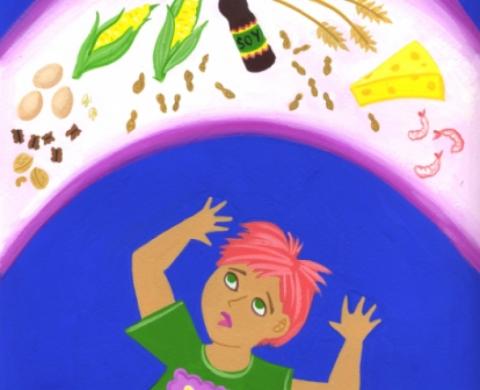“I have your son’s test results,” the doctor said over the phone.
I mechanically reached for paper and pen with a sinking feeling in the pit of my stomach. I knew that I was about to get some answers to our questions, but at what cost?
“Please write this down,” the doctor continued. “Milk, eggs, wheat, soy, corn, oats, fish, shell-fish, peanuts and tree nuts. Adam is severely allergic to these foods and it could be very dangerous if he eats, or even touches, any of them.”
I scribbled the words on the paper while I thought, “No grilled cheese, peanut butter and jelly sandwiches, pizza, chicken nuggets, ice cream, bread, scrambled eggs, cake, cookies or spaghetti.” The doctor interrupted my thoughts. “He could go into anaphylactic shock if he has any of these foods. Anaphylactic shock is a severe allergic reaction. It can be deadly.
“Deadly,” I wrote. Then circled.
“There is no cure for food allergies,” the doctor continued. “The only treatment is epinephrine, which must be administered at the first sign of a reaction. This is your only defense. I’ll call in a prescription to your pharmacy. Get it today and make sure that you keep it near him- always. Now, do you have any questions?”
I had a hundred questions, but in a daze, only one came out of my mouth.
“What can I feed him for dinner tonight?”
My son was eleven months old when we got that phone call. Several months earlier, he had been diagnosed with infant eczema- - a non-contagious inflammation of the skin. The eczema was being treated with steroid creams. As Adam began eating solid foods, we noticed that his skin was more rashy-looking and irritated. He also developed hives- often. We consulted an allergist after giving Adam yogurt for the first time. His skin had become bright red around his mouth. While no one else in the family had food allergies, we suspected that Adam could be allergic to cow’s milk. We were shocked to find out that he was allergic to many other foods as well.
After learning of Adam’s allergies, the question of what to feed him became our family’s primary focus. We spent the next several months arming ourselves with information. We called food manufacturers and asked specific questions about ingredient labels. We needed to know what was in a product, and if anything else was run on the same product line, thereby contaminating the food. We got four prescriptions for epinepherine- one for upstairs, one for downstairs, one in the diaper bag and one for a spare. We got a medical bracelet and a sticker for the car seat in the event we were in an accident and no one was conscious to tell rescue workers about Adam’s food allergies. We consulted nutritionists to find out how to make sure he was getting enough protein, calcium and other necessary nutrients. We had to learn how to cook and bake differently. Even with all this information and planning, we still weren’t careful enough. There are over 30,000 emergency room visits each year due to allergic reactions. We became part of that statistic about a year after the initial diagnosis.
It happened so fast. The family was enjoying homemade muffins for a snack. Adam’s muffin looked just like ours because I always tried to make his food look like everyone else’s so he wouldn’t feel different. This time though, I had accidentally given him the regular muffin- filled with milk, chocolate chips, eggs and wheat flour. His skin turned bright red, as though he had a severe sunburn. His face and tongue became swollen and he was violently scratching his body. I grabbed his medication and dialed “911”. After one ring, I hung up and told my husband that it would be faster if we just drove to the hospital. As we got into the car, a fire truck, police car, and an ambulance arrived.
“Did you just call?” the paramedic asked. He took one look at my swollen red son and whisked him off to the ambulance. Within moments Adam had an IV in one arm, electrodes taped to his chest and an oxygen mask over his nose and mouth. They administered epinephrine immediately and the swelling began to decrease.
“It’s a good thing you called us. We were able to trace it and get right to you.” the paramedic said. “You shouldn’t risk getting him to the hospital yourselves.”
More lessons learned. Recently, in our family doctor’s office, Adam was given an inhaler to try to help with a cough. After he inhaled the medication, in the presence of the doctor, I noticed that lactose (milk sugar) was in the product. Adam was able to blow out the powder and we gave him an antihistamine and monitored him for a few hours. Just another close call.
We check every food, medication, shampoo, lotion, and craft product for possible allergens. We are seven years into this journey now. Adam has outgrown some of his food allergies. Currently, he must avoid dairy, eggs, peanuts, tree nuts and shellfish. Adam wears his medication in a waist-pack strapped on like a belt. He attends public school where the teachers have been trained about what to do in the event of an allergic reaction. His friends are helpful and matter-of-fact about his allergies.
That phone call changed our lives. Our family has had to think about food in a very different way. We eat better now because we are aware of the ingredients in our food. It is safer, and healthier, for us to eat fruits and vegetables and foods that we make at home. Hopefully there will be a cure for food allergies in the next few years. Until then, we’ll read every label and watch every bite.




